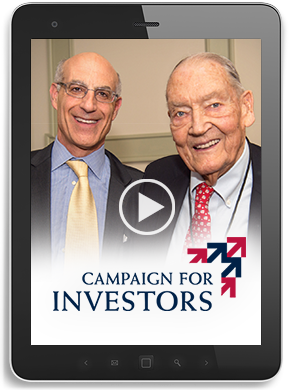Investors Should Reconsider Target-Date Funds

Rebalance’s Mitch Tuchman speaks with Jeff Brown at U.S. News about how target-date funds can mean double the fees for retirement investors.
Back in the day, investors paid a pretty penny for professional help in building a retirement portfolio of stocks, bonds and cash, and on managing it as the years went by. Now it’s easy – and cheap – with a single target-date fund matched to one’s retirement schedule, whether that’s 10, 20 or 30 years off.
But target-date funds got a black eye in the financial crisis, when some investors nearing retirement suffered losses in funds they’d thought were safe.
So what’s the thinking on target-date funds today?
“Target-date funds are not the silver bullet retail investors dream of when they think about saving for retirement,” says Aaron Gilman, president and chief investment officer of IFP Wealth Management of Tampa, Florida.
But he says target-date funds have been effective at “promoting responsible investor behavior,” such as focusing on long-term goals rather than reacting to the markets’ short-term ups and downs.
During the market hysteria from the end of June 2008 to the end of May the next year, only 3.5 percent of target-date investors using T. Rowe Price funds changed their holdings, a rate only a quarter that of holders of non-target-date funds, says Joe Martel, asset allocation portfolio specialist and member of the Target Date Investment team at T. Rowe Price, one of the largest providers of these funds.
“So because the vast majority of target-date investors stayed invested, they benefited from the rebalancing that occurred and participated in the market recovery we have seen over the past several years,” he says.
Because target-date funds hold other funds in varying proportions, depending on the managers’ strategies and the investors’ retirement dates, it’s difficult to generalize about the funds’ investment performance. There’s no simple benchmark to measure against.
But a 2014 study by Financial Engines, an investment-advisory firm, and the consulting firm Aon Hewitt found that investors who used target-date funds earned 3.32 percent more per year than investors who managed investments on their own. That edge would produce a substantially larger nest egg over many years of compounding.
The typical target-date fund owns a basket of index-style mutual funds, which in turn own stocks and bonds. The investor buys a fund with a target date matching the expected retirement date. For a young investor, the fund is heavy on stocks, emphasizing growth over safety. As the years pass, more and more of the fund’s holdings are switched to bonds and cash, to emphasize safety. And the portfolio is adjusted each year to stick to the desired asset allocation as market conditions change, a task many investors dread.
All this is automatic, making the target-date fund a true fire-and-forget investment, appealing to those who want to leave decisions to the pros. Many target-date funds also include stocks in foreign companies and small companies, sectors difficult for many investors to understand on their own. Fees vary but can be quite low, much less than an investor would pay a financial advisor to build and manage a tailor-made portfolio.
Assets in target-date funds have grown from about $10 billion in 2006 to more than $700 billion in 2015, according to Morningstar, largely because the funds have become popular in 401(k)s and similar workplace retirement plans. Many employers now use target-date funds as the default, the investment chosen for an employee who does not opt for something else. The biggest providers are Vanguard, Fidelity and T. Rowe Price.
In 2008, investors’ faith in target-date funds was shaken by sizable losses in funds aimed at people retiring only two years later. In fact, many of these funds performed as designed, losing less than the broad stock market thanks to the dampening effect of the funds’ bonds and cash. But many investors had not realized that a target-date fund would continue to hold so many stocks that close to the target date. The funds do that to offset the risk of inflation during a 20- or 30-year retirement.
“One misunderstanding involved a set-it-and-forget-it reputation that some target-date funds seemed to have at that time,” Martel says. “Some investors may have misinterpreted that reputation as a sort of implied guarantee that fund prices couldn’t go down, which is not the case.”
Under pressure from regulators and Congress, funds revamped marketing materials to better explain how target-date funds work.
Still, the landscape can be confusing. Mitch Tuchman, Managing Director of Rebalance, a retirement management firm in Palo Alto, California, says the layers of fees are often poorly disclosed.
“Many TDFs charge a fee for the fund itself, but the fund buys other funds, so some fund companies do what we call ‘double dipping,’ meaning they buy their own funds so they get fees for the TDF and [also] the funds within the TDF,” he says. “It is very hard to get a good handle on whether or not a TDF is double dipping, so they are not transparent with fees at all.”
Investors who get target-date funds through workplace plans are stuck with the limited options the employer offers. Those who buy on their own, in IRAs or taxable accounts, can benefit from shopping around.
So the rule is: study up. Not only will fees vary, but the asset mix of two funds can be very different even if they have the same target date. The pace of the shift from stocks to bonds is called the “glide path.”
Some funds – the “to” variety – aim to be relatively safe when the target date arrives. Others – the “through” funds – keep a large stock allocation even after the target date, to provide some growth throughout retirement.
T. Rowe Price, for example, uses a 90 percent stock and 10 percent bond allocation for investors 30 years from retirement, and a 20 percent, 80 percent stock-bond mix 30 years after the retirement date. But some of the firm’s funds are more conservative at the retirement date, with a 42.5 percent stock allocation, while others are more aggressive, leaving 55 percent in stocks. Other providers mix stocks and bonds differently.
“There is no standard formula that is used by all managers,” Martel says, “just as there is no standard formula across managers for non-target-date funds.”






